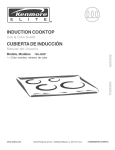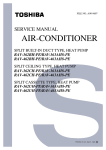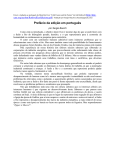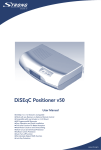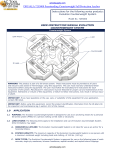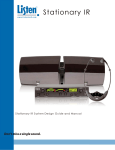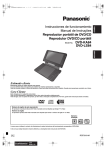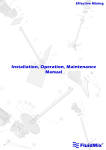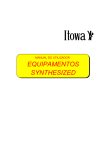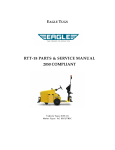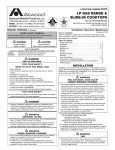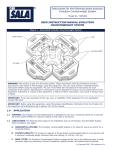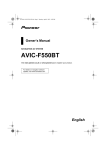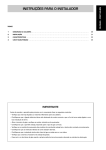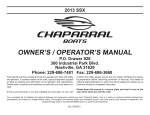Download OWNER´S MANUAL - Powertec Outboards
Transcript
40HP OWNER´S MANUAL Read this manual carefully before operating this outboard motor. Keep this manual onboard in a waterproof bag when boating. This manual should stay with the ouboard motor if it is sold. General Information Thank you for choosing a Outboards motor. This Owner’s Manual contains information needed for proper operation, maintenance and care. A thorough understanding of these simple instructions will help you obtain maximum enjoyment from your new Outboards. If you have any question about the operation or maintenance of your outboard motor, please consult a Outboards dealer. In this Owner’s Manual particularly important information is distinguished in the following ways. The Safety Alert Symbol means ATTENTION! BECOME ALERT! YOUR SAFETY IS INVOLVED! WARNING Failure to follow WARNING instructions could result in severe injury or death to the machine operator, a bystander, or a person inspecting or repairing the outboard maintenance by correctly following the instructions in the owner’s manual. Note that if you do not follow these instructions, not only may the product break down, but the warranty will also be voided. Some countries have laws or regulations restricting users from taking the product out of the country where it was purchased, and it may be impossible to register the product in the destination country. Additionally, the warranty may not apply in certain regions. When planning to take the product to another country, consult the dealer where the product was purchased for further information. If the product was purchased used, please consult your closest dealer for customerregistration,and to be eligible for the speci CAUTION A CAUTION indicates special precautions that must be taken to avoid damage to the outboard motor. NOTE: A NOTE provides key information to make procedures easier or clearer. Outboards continually seeks advancements in product design and quality. Therefore, while this manual contains the most current product information available at the time of printing, there may be minor discrepancies between your machine and this manal. If there is any question concerning this manual, please consult your Outboards dealer. To ensure long product life, Outboards recomends that you use the product and perform NOTE: The 40HP and the standard accessories are used as a base for the explanations and illustrations in this manual. Therefore some items may not apply to every model. General Information 40HP OWNER’S MANUAL ©2009 Outboards Group, CV. 1st Edition, Marzo 2011 All rights reserved. Any reprinting or unauthorized use without the written permission of Outboards Group, CV. is expressly prohibited. Index General information .......................... 1 Identification numbers record........... 1 Outboard motor serial number .......... 1 Key number..................................... 1 C-Tick label ............................... 1 Safety information ............................ 2 Important labels.............................. 3 Warning labels ................................ 3 Fueling instructions .......................... 4 Gasoline ...................................... 4 Engine oil ...................................... 4 Battery requirement.......................... 4 Battery specifications ..................... 4 Without a rectifier or Rectifier Regulator .................................... 4 Propeller selection.......................... 5 Start-in-gear protection .................... 5 Basic components ............................ 6 Main components............................. 6 Fuel tank ..................................... 7 Fuel joint ...................................... 7 Fuel gauge .................................... 7 Fuel tank cap ................................. 7 Air vent screw ................................. 7 Remote control................................ 7 Remote control lever ......................... 7 Neutral interlock trigger ................... 8 Neutral throttle lever........................ 8 Tiller handle .................................. 8 Gear shift lever................................ 9 Throttle grip .................................. 9 Throttle indicator ............................. 9 Throttle friction adjuster................... 10 Engine stop lanyard switch ............. 10 Engine stop button .......................... 11 Choke knob for pull type ................. 11 Manual starter handle ..................... 11 Main switch .................................. 12 Steering friction adjuster ................. 12 Steering friction adjuster ................. 12 Power trim and tilt switch on remote control or tiller handle ................... 12 Trim tab with anode ........................ 12 Trim 1. rod º (tilt pin) .............................. 13 Tilt lock mechanism......................... 13 Tilt support lever for power trim and tilt or hydro tilt model............. 13 Top cowling lock lever(s) turn type)......14 Tachometer ................................. 14 Speedometer................................ 14 Hour meter ................................ 14 Warning system ............................. 14 Overheat warning ............................ 15 Operation .................................... 16 Installation................................. 16 Mounting the outboard motor .......... 16 Clamping the outboard motor.......... 17 Breaking in engine ......................... 18 Gasoline and engine oil mixing chart (25:1).................................. 18 Procedure for pre-mixed models .....18 Preoperation checks ...................... 19 Fuel .......................................... 19 Oil ............................................ 19 Controls .................................19 Engine .................................... 20 Filling fuel and engine oil ............... 20 Filling fuel for portable tank ............. 20 Gasoline and oil mixing ................... 20 Operating engine ........................... 21 Feeding fuel (portable tank) ............ 21 Starting engine .............................. 22 Warming up engine........................ 28 Choke start models ......................... 28 Electric start and prime start models ....................................... 28 Shifting ...................................... 29 Forward (tiller handle and rmote control models) ................................ 30 Reverse (automatic reverse lock and power trim and tilt modls)................ 30 Reverse (manual tilt and hydro tilt models) ....................................... 30 Stopping engine ............................. 31 Procedure ............... ........................ 31 Index Trimming outboard motor............... 32 Adjusting trim angle ........................ 32 Adjusting trim angle for hydro tilt models ........................................ 32 Adjusting boat trim .......................... 33 Tilting up and down ........................ 34 Procedure for tilting up (hydro tilt models) ......................... 35 Procedure for tilting up .................... 36 Procedure for tilting down ............... 36 Procedure for tilting down (manual and hydro tilt models) ..... 37 Cruising in shallow water ............... 37 Hydro tilt models ............................. 38 Power trim and tilt models / power tilt models........................... 38 Cruising in other conditions............ 39 Maintenance............................... 40 Specifications .............................. 40 Transporting and storing outboard motor ........ 42 Clamp screw mounting models ....... 42 Storing outboard motor ................... 42 Procedure ................................... 43 L u b r i c a t i o n (except oil injection models) ...44 Battery care................................. 44 Cleaning the outboard motor .......... 45 Checking painted surface of motor......................................... 45 Periodic maintenance..................... 45 Replacement parts .......................... 45 Maintenance chart .......................... 46 Greasing..................................... 48 Cleaning and adjusting spark plug ........49 Checking fuel system ...................... 50 Inspecting fuel filter ......................... 50 Cleaning fuel filter ........................... 51 Inspecting idling speed.................... 51 Checking wiring and connectors .... 52 Exhaust leakage............................. 52 Water leakage ............................... 52 Checking power trim and tilt power tilt system ......... 53 Checking propeller .......................... 53 Removing the propeller ................... 53 Installing the Propeller..................... 54 Changing gear oil ............................ 54 Cleaning fuel tank ........................... 55 Inspecting and replacinganode(s)....... 56 Checking battery (for electric start models) ................. 56 Connecting the battery ................... 57 Disconnecting the battery................ 58 Checking top cowling ...................... 58 Coating the boat bottom .................. 58 Trouble Recovery............................ 59 Troubleshooting ............................. 59 Temporary action in emergency .... 62 Impact damage ............................ 62 Replacing fuse .............................. 63 Power trim and tilt / power tilt will not operate.................................. 63 Starter will not operate .................... 63 Emergency starting engine ............. 64 Treatment of submerged motor ..... 65 Procedure................................... 65 General Information The outboard motor serial number is stamped on the label attached to the port side of the clamp bracket or the upper part of the swivel bracket. Record your outboard motor serial number in the spaces provided to as sist you in ordering spare parts from your Outboards dealer or for reference in case your outboard motor is stolen. Before mounting or operating the outboard motor, read this entire manual . Reading itshould give you an understanding of the motor and its operation. Before operating the boat, read any owner’s or operator’s manuals supplied with it and all labels . Be sure you understand each item before oper ating. Do not overpower the boat with this out board motor. Overpowering the boat culd result in loss of control. The rated power of the outboard should be equal to or less than the rated horsepower capacity of the boat. If the rated horsepower capacity of the boat is unknown, consult the dealer or boat manufacture r. 1. Outboard motor serial number location General Information Key number If a main key switch is equipped with the motor, the key identification number is stamped on your key as shown in the illustration Record this number in the space provided for Do not modify the outboard. Modifications could make the motor unfit or unsafe to use. Incorrect propeller selection and incor rect use may not only cause engine damage, but also adversely affect fuel consumption. Consult your dealer for correct use. Never operate after drinking alcohol or taking drugs . About 50% of all boating fatalities involve intoxic ation. Safety information Have an approved personal flotation device (PFD) on board for every occupant. It 1 General Information is a good idea to wear a PFD whenever boating. At a minimum, children and nonswimmers should always wear PFDs, and everyone should wear PFDs when there are potentially hazardous bo ating conditions. Gasoline is highly flammable , and its vapors are flammable and explosive . Handle and store gasoline carefull y. Make sure there are no gas fumes or leaking fuel before starting the engine. This product emits exhaust gases which contain carbon monoxide, a colorless, odorless gas which may cause brain damage or death when inhaled . Symptoms include nausea , dizziness , and drowsiness. Keep cockpit and cabin areas well ventilated. Avoid blocking exhaust outlets. Check throttle , shift, and steering for proper operation before starting the engine. Attach the engine stop switch la nyard to a secure place on your clothing, or your arm or leg while operating. If you accidentally leave the helm, the lanyard will pull from the switch, stopping the engine. Know the marine l aws and regulations where you will be bo ating - and obey them. Stay informed about the we ather. Check weather forecasts before bo ating. Avoid boating in hazardous we ather. 2 Tell someone where you are going: leave a Float Plan with a responsible person . Be sure to cancel the Flo at Plan when you return. Use common sense and good judgment when boating. Know your abilities , and be sure you understand how your boat handles under the different bo ating conditions you may encounter. Operate within your limits, and the limits of your boat. Always operate at safe speeds , and keep a careful watch for obstacles and other traffic. Always w atch carefully for swimmers during the engine operation. Stay away from swimming areas. When a swimmer is in the w ater near you shift into neutral and shut off the engine. Do not illegally discard empty containers used to replace or replenish oil . For the correct processing of empty containers , consult the dealer where you purchased the oil. When replacing oils used to lubricate the product (engine or gear oil), be sure to wipe away a ny spilt oil. Never pour oil with- out using a funnel or similar device . If necessary, verify the necessary replacement procedure with the dealer. Never illegally discard (dump) the product . Outboardsrecommends consulting the dealer on discarding the product General Information <Gasoline Minimum rated capacity (20HR/IEC): 40HP Recommended gasoline: Regular unleaded gasoline Regulator If knocking or pinging occurs, use a differentbrand of gasoline or premium unleaded fuel. If unleaded CAUTION gasoline is not available, then premium gasoline can be used. A battery cannot be connected to Engine oil Recommended engine oil: Outboards 2-stroke outboard motor oil If you wish to use a battery with the er Regulator. Using a maintenancefree battery with the above models can shorten the life of the bat- If the recommended engine oil is not available, another 2-stroke TC-W3 rating may be used. Battery requirement sories rated to withstand 18 volts or higher with the above models. ConCAUTION sult your Outboards dealer for Do not use a battery that does not details on installing an optional cations is used, the electric system could perform poorly or be overloaded, causing electric system damage. For electric start models, choose a battery which meets the following Minimum cold cranking amps (CCA/ EN): 40ª430.0 A - Propeller selection The performance of your outboard motor will be critically affected by your choice of propeller, as an incorrect choice could adversely affect performance and could also seriously damage the motor. Engine speed depends on the propeller size and boat load. If engine speed is too high or too low for good engine performance, this will have an adverse effect on the engine. Outboards with propellers chosen to perform 3 General Information Never illegally discard (dump) the product. Outboards recommends consulting the dealer on discarding the product. starting device. Important labels Label Warning labels Fueling instructions WARNING The engine will not start unless the shift control is in neutral position. WARNING GASOLINEAND ITS VAPORSARE HIGHLY FLAMMABLE AND EXPLOSIVE! Do not smoke when refueling, and keep away from sparks , flames, or other sources of ignition. Stop engine before refueling. Refuel in a well-ventil ated area . Refuel portable fuel tanks off the bo at. Take care not to spill gasoline . If gasoline spills, wipe it up immediately with dry rags. Do not overfill the fuel tank. WARNING Be sure shift control is in neutral before starting engine . (except 2HP) Do not touch or remove electrical parts when starting or during oper ation. Keep hands, hair, and clothes away from flywheel and other rot ating parts while engine is running. Label WARNING This engine is equipped with a neutral 4 Tighten the filler cap securely after refueling. If you should swall ow some gasoline, inhale a lot of gasoline v apor, or get gasoline in your eyes, get immediate medical attention. If any gasoline spills onto your skin , imediately wash with so ap and water. Change clothing if gasoline spills on it. CAUTION Touch the fuel nozzle to the filler opening or funnel to help prevent electrostatic sparks. General Information well over a range of applications, but there may be uses where a propeller with a different pitch would be more appropriate. For a greater operating load, a smaller-pitch propeller is more suitable as it enables the correct engine speed to be maintained. Conversely, a larger-pitch propeller is more suitable for a smaller operating load. Outboards dealers stock a range of propellers, and can advise you and install a propeller on your outboard that is best suited to your application. upper half of the operating range at full throttle with the maximum boat load. If operating conditions such as light boat loads then allow the engine r/min to rise above the maximum recommended range, reduce the throttle setting to maintain the engine in the proper operating range. For instructions on propeller removal and installation, see page 57. 5 General information Start-in-gear protection Outboards motor or Outboards -ap-proved remote control units are equipped with start-in-gear protection device(s). This feature permits the engine to be started only when it is in neutral. Always select neutral 1. Propeller diameter in inches before starting the engine. 2. Propeller pitch in inches 3. Type of propeller (propeller mark) NOTE: Select a propeller which will allow the engine to reach the middle or 5 General Information Componentes principaies NMain components NOTE: * May not be exactly as shown; also may not be included as standard equipment on all models. 1. Top cowling 2. Dated superior da hood 3. Á node 4. Anticavation Plate 5. Nadadeira of compensaçao (anode) 6. Propeller 7. Entry water 8.trim * 9. Support for fixation 10. Fricction regulator 11. Manual starting handle 12. * Starting button 13. Handle choke 14. serial number of outboard motor * 15. Command poppy * 16. Throttle controller * 17. MOTORr stop / stop switch out do do motor * 18. fixation handle aft * 19. BloqueIo levered to give elevaçao * 20. Refrigerator D’Chivato refrigeraçao Water 21. Motor support bracket * 22. Remote control box (side mount type) * 23. Fuel Tank 6 24. Tachometer * 25. Speedometer * 26. Hour Meter * General Information Fuel tank Air vent screw This screw is on the fuel tank cap. To If your model was equipped with a por- loosen the screw, turn it counterclocktable fuel tank, its function is as follows. wise. WARNING The fuel tank supplied with this engine is its dedicated fuel reservoir and must not be used as a fuel storage container. Commercial users should conform to relevant licensing or approval authority regulations. 1. Fuel joint 2. Fuel gauge 3. Fuel tank cap 4. Air vent screw Fuel joint This joint is used to connect the fuel line. Fuel gauge This gauge is located on either the fuel tank cap or on the fuel joint base. It shows the approximate amount of fuel remaining in the tank. Remote control The remote control lever actuates both the shifter and the throttle. The electrical switches are mounted on the remote control box. 1. Power trim and tilt switch 2. Remote control lever 3. Neutral interlock trigger 4. Neutral throttle lever 5. Main switch / choke switch 6. Engine stop lanyard switch 7. Throttle friction adjuster Remote control lever Moving the lever forward from the neutral position engages forward gear. Pulling the lever back from neutral engages reverse. The engine will continue to run at idle until the lever is moved about 35° (a detent can be felt). Moving the lever farther opens the throttle, and the engine will begin to accelerate. Fuel tank cap This cap seals the fuel tank. When removed,the tank can be filled with fuel. To remove the cap, turn it counterclockwise. 7 Basic Components when the neutral throttle lever is in the closed position. 1. Neutral “ N ” 2. Forward “F ” 3. Reverse “R” 4. Shift 5. Fully closed 6. Throttle 7. Fully open Choke Switch To activate the choke system, push the pricipal switch while turning the key onto “ON” (activated) or “START” (start) position. The choke system will start sending the fuel requiered for the engine to start. Realising the key will make the choke to disconect automatically. Neutral throttle lever To open the throttle without shifting into either forward or reverse, put the remote control lever in the neutral position and lift the neutral throttle lever. NOTE: The neutral throttle lever will operate only when the remote control lever is in neutral. The remote control lever will operate only 8 1. Fully open 2. Fully closed Tiller handle To change direction, move the tiller handle to the left or right as necessary Choke Switch To activate the choke system, push the pricipal switch while turning the key onto “ON” (activated) or “START” (start) position. The choke system will start sending the fuel requiered for the engine to start. Realising the key will make the choke to disconect automatically. Basic Components Throttle indicator The fuel consumption curve on the throttle undicator shows the relative amount of fuelconsumed for each throttle position. Choose the setting that offers the best performance and fuel economy for the desired operation. Gear shift lever Pulling the gear shift lever towards you puts the engine in forward gear so that the boat moves ahead. Pushing the lever away from you puts the engine in reverse gear so that the boat moves astern. 1. Throttle indicator Throttle friction adjuster A friction device provides adjustable resistance to movement of the throttle grip or the remote control lever, and can be set according to operator preference. To increase resistance, turn the adjuster clockwise. To decrease resistance, turn the adjuster counterclockwise. 1. Forward “ r ” 2. Neutral “ f” 3. Reverse “n ” WARNING Do not overtighten the friction adjuster. Throttle grip If there is too much resistance, it could The throttle grip is on the tiller handle. Turn be difficult to move throttle lever or grip, the grip counterclockwise to increase speed which could result in an accident. and clockwise to decrease speed. 9 Basic Components The engine cannot be started with the lock plate removed. When constant speed is desired, tighten the adjuster to maintain the desired throttle setting.Engine stop lanyard switch The lock plate must be attached to the en- 1. Lanyard gine stop switch for the engine to run. The 2. Lock plate lanyard should be attached to a secure place on the operator’s clothing, or arm or leg. Should the operator fall overboard or leave the helm, the lanyard will pull out the lock plate, stopping ignition to the engine. This will prevent the boat from running away under power. WARNING WARNING Attach the engine stop switch lanyard to a secure place on your clothing, or your arm or leg while operating. 1. Lanyard 2. Lock plate Engine stop button To open the ignition circuit and stop the engine, push this button. Do not attach the lanyard to clothing that could tear loose. Do not route the lanyard where it could become entangled, preventing it from functioning. Avoid accidentally pulling the lanyard during normal operation. Loss of engine power means the loss of most steering control. Also, without engine power, the boat could slow rapidly. This could cause people and objects in the boat to be thrown forward. NOTE: 10 Choke knob for pull type To supply the engine with the rich fuel mix ture required to start, pull out this knob. Basic Components With the main switch in the “” (off) position, the electrical circuits are off, and the key can be removed. G “” (on) With the main switch in the “ ” (on) position, the electrical circuits are on, and the key cannot be removed. Manual starter handle To start the engine, first gently pull the han dle out until resistance is felt. From that position, then pull the handle straight out quickly to crank the engine. (start)G “ With the main switch in the “” (start) position, the starter motor turns to start the engine. When the key is released, it returns automatically to the “ ” (on) position. set according to operator preference. An adjuster lever is located on the bottom of the tiller handle bracket. To increase resistance, turn the lever to the left. To decrease resistance, turn the lever to the right. WARNING Do not overtighten the friction adjuster. If there is too much resistance, it could be difficult to steer, which could result in an accident. Main switch The main switch controls the ignition system; its operation is described below. G “” (off) 11 Basic Components outboard motor up, then tilts it up. Pressing the switch “ ” (down) tilts the outboard mo tor down and trims it down. When the switch is released, the outboard motor will stop in ts current position. NOTE: For instructions on using the power trim Steering friction adjuster and A friction device provides adjustable resis- tilt switch, see pages 37 and 39. tance to the steering mechanism, and can be set according to operator preference. An adjusting screw or bolt is located on the swivel bracket. WARNING An improperly adjusted trim tab could To increase resistance, turn the adjuster cause difficult steering. Always test run clockwise. To decrease resistance, turn the after the trim tab has been installed or readjuster counterclockwise. placed to be sure steering is correct. Be sure you have tightened the bolt after adjusting the trim tab. WARNING Do not overtighten the friction adjuster. If there is too much resistance, it could be difficult to steer, which could result in an accident. Power trim and tilt switch on remote control or tiller handle The power trim and tilt system adjusts the outboard motor angle in relation to the transom. Pressing the switch “ ” (up) trims the 12 If the boat tends to veer the left (port side), turn the trim tab rear end to the port side “A” in the figure. If the boat tends to veer the right (starboard side), turn the trim tab end to the starboard side “B” in the figure. Componentes básicos CAUTION The trim tab also serves as an anode to protect the engine from electrochemical corrosion. Never paint the trim tab as it will become ineffective as an anode. 1. Tilt lock lever To lock it, set the tilt lock lever in the “ 1” (lock) position. To release, push the tilt lock lever in the “1 ” (release) position. Tilt support lever for power trim and 1. Trim tab 2. Bolt tilt or hydro tilt model To keep the outboard motor in the tilted up position, lock the tilt support lever to the clamp bracket. Trim rod (tilt pin) The position of the trim rod determines the minimum trim angle of the outboard motor in relation to the transom. Tilt lock mechanism The tilt lock mechanism is used to prevent the outboard motor from lifting out of the water when in reverse gear. 13 Basic Components OutBoards dealer. Warning system : Do not continue to operate the engine if a warning device has activated. Consult your Outboards dealer if the problem cannot be located and corrected. CAUTION Tachometer This gauge shows the engine speed. Overheat warning This engine has an overheat warning device. If the engine temperature rises too high, the warning device will activate. Activation of warning device G The engine speed will automatically decrease to about 2000 r/min. Hour meter This gauge shows the number of hours the NOTE: This gauge can be set to count the amount of time elapsed either when the main switch is on or only when the engine is running. For instructions on how to select the counting mode, consult your Outboards 14 Basic Components If equipped with an overheat warning indicator, it will light. The buzzer will sound (if equipped on the tiller handle, remote control box, or main switch panel). If the warning system has activated, stop the engine and check the cooling water inlet for clogging. 15 Functioning Installation CAUTION Incorrect engine height or obstructions to smooth water flow (such as the design or condition of the boat, or accessories such as transom ladders or depth finder transducers) can create airborne water spray while the boat is cruising. Severe engine damage may result if the motor is operated continuously in the presence of airborne water spray. NOTE: During water testing check the buoyancy of the boat, at rest, with its maximum load. Check that the static water level on the exhaust housing is low enough to prevent water entry into the powerhead, when water rises due to waves when the outboard is not running. Mounting the outboard motor WARNING Overpowering a boat could cause severe instability. Do not install an outboard motor with more horsepower than the maximum rating on the capacity plate of the boat. If the boat does not have a capacity plate, consult the boat manufacturer. The information presented in this section is intended as reference only. It is not possible to provide complete instructions for every possible boat and motor combination. Proper mounting depends in part on experience and the WARNING Improper mounting of the outboard motor could result in hazardous conditions such as poor handling, loss of control, or fire hazards. Observe the following: For permanently mounted models, your dealer or other person experienced in proper rigging should mount the motor. If you are mounting the motor yourself, you should be trained by an experienced person. For portable models, your dealer or other person experienced in proper outboard motor mounting should show you how to mount your motor. Mount the outboard motor on the center line (keel line) of the boat, and ensure that the boat itself is well balanced. Otherwise the boat will be hard to steer. For boats without a keel or which are asymmetrical, consult your dealer. 1. Center line (keel line) Mounting height (boat bottom) To run your boat at optimum efficiency, the water resistance (drag) of the boat and outboard motor must be made as little as possible. The mounting height of the outboard 16 Functioning motor greatly affects the w ater resistance . If the mounting height is too high, cavitation tends to occur, thus reducing the propulsion; and if the propeller tips cut the ai r, the engine speed will rise abnormally and cause the engine to overheat. If the mounting height is too low, the water resistance will increase and thereby reduce engine efficien cy. Mount the outboard motor so that the anti-c avitation plate is 25mm (1in.) under the bottom of the boat. WARNING Loose clamp screws could allow the outboard motor to fall off or move on the transom. This could cause loss of control and serious injury. Make sure the transom screws are tightened securel y. Occasionally check the screws for tightness during operation. NOTE: The optimum mounting height of the outboard motor is affected by the boat/motor combination and the desired use . Test runs at different heights can help dete rmine the optimum mounting height. Consult your Outboards dealer or boat manufacturer for further inform ation on determining the proper mounting height. 2. If the engine restraint cable attachment is equipped on your engine, an engine restraint cable or chain should be used. Attach one end to the engine restraint cable attachment and the other to a secure mounting point on the boat. Otherwise the engine could be completely lost if it accidentally falls off the transom. For instructions on setting the trim angle of the outboard motor, see page 34. Clamping the outboard motor 1. Place the outboard motor on the transom so that it is positioned as close to the center as possible . Tighten the transom clamp screws evenly and securel y. Occasionally check the clamp screws for tightness during operation of the outboard motor because they could be- 17 Functioning 3. Secure the clamp bracket to the transom using the bolts provided with the outboard (if packed). For details, consult your Outboards dealer. Gasoline and engine oil mixing chart (25:1) WARNING Avoid using bolts, nuts or washers other than those contained in the engine packaging. If used, they must be of at least the same quality of material and strength and must be tightened securely. After tightening test run the engine and check their tightness. WARNING Be sure to mix gasoline and oil completely otherwise the engine may be damaged. Procedure for pre-mixed models Run the engine under load (in gear with a propeller installed) as follows. 1. First 10 minutes: Run the engine at the lowest possible speed. A fast idle in neutral is best. 2. Next 50 minutes: Do not exceed half throttle (approximately 3000 r/min). Vary engine speed Breaking in engine occasionally. If you have an easy-planYour new engine requires a period of breaking boat, accelerate at full throttle onto in to allow mating surfaces of moving parts to plane, then immediately reduce the wear in evenly. Correct break-in will help enthrottle to 3000 r/min or less. sure proper performance and longer engine 3. Second hour: life. Accelerate at full throttle onto plane, then reduce engine speed to three-quarter throttle (approximately 4000 r/min). CAUTION Vary engine speed occasionally. Run at Failure to follow the break-in procedure full throttle for one minute, then allow could result in reduced engine life or about 10 minutes of operation at threeeven severe engine damage. quarter throttle or less to let the engine 18 Functioning cool. 4.Third through tenth hours: Avoid operating at full throttle for more than 5 minutes at a time. Let the engine cool between full-throttle runs. Vary engine speed occasionally. 5.After the first 10 hours: Operate the engine normally. Use the standard premix ratio of gasoline and oil. For details on mixing fuel and oil, see page 26. WARNING If any item in the preoperation check is not working properly, have it inspected and repaired before operating the outboard motor. Otherwise an accident could occur. CAUTION Do not start the engine out of water. Overheating and serious engine damage can occur. Fuel Check to be sure you have plenty of fuel for your trip. Make sure there are no fuel leaks or gasoline fumes. Check fuel line connections to be sure they are tight (if equipped Outboards fuel tank or boat tank). Oil Check to be sure you have plenty of oil for your trip. Controls 5.Check throttle, shift, and steering for proper operation before starting the engine. The controls should work smoothly, without binding or unusual free play. Look for loose or damaged connections. Check operation of the starter and stop switches when the outboard motor is in the water. Engine Check the engine and engine mounting. Look for loose or damaged fasteners. Check the propeller for damage. Filling fuel and engine oil Filling fuel for portable tank WARNING Gasoline and its vapors are highly flammable and explosive. Keep away from sparks, cigarettes, flames, or other sources of ignition. 1.Remove the fuel tank cap. 2.Fill the fuel tank carefully. 3.Close the cap securely after refueling. Wipe up any spilled fuel. Fuel tank capacity (if equipped Outboard tank): 24 L (6.34 US gal) (5.28 Imp.gal) Be sure the fuel tank is positioned on a secure, flat surface, and that the fuel line is not twisted or flattened, or likely to contact sharp objects (if equipped Outboards fuel tank or boat tank). 19 Functioning Filling fuel for portable tank WARNING Gasoline and its vapors are highly flammable and explosive. Keep away from sparks, cigarettes, flames, or other sources of ignition. 1.Remove the fuel tank cap. 2.Fill the fuel tank carefully. 3.Close the cap securely after refueling. 4.Wipe up any spilled fuel. Fuel tank capacity (if equipped Outboard fuel tank): 24 L (6.34 US gal) (5.28 Imp.gal) 2. Replace the fuel tank cap and close tightly. 3. Shake the fuel tank to mix the fuel thoroughly. 4. Make sure that the oil and gasoline are mixed. If equipped with a built-in fuel tank 1. Pour oil into a clean fuel can, and then add gasoline. 2. Replace the fuel can cap and close tightly 3. Shake the fuel can to mix the fuel thoroughly. 4. Make sure that the oil and gasoline are mixed. 5. Pour the gasoline and oil mixture into the 20 Functioning CAUTION Avoid using any oil other than the specified type. Use a thoroughly blended fuel-oil mixture. If the mixture is not thoroughly mixed, or if the mixing ratio is incorrect, the following problems could occur. Low oil ratio: Lack of oil could cause major engine trouble, such as piston seizure. High oil ratio: Too much oil could cause fouled spark plugs, smoky exhaust, and heavy carbon deposits. When the air vent screw is loosened, gasoline vapor will be released. Gasoline is highly flammable, and its vapors are flammable and explosive. Refrain from smoking, and keep away from open flames and sparks while loosening the air vent screw. This product emits exhaust gases which contain carbon monoxide, a colbrain damage or death when inhaled. Symptoms include nausea, dizziness, and drowsiness. Keep cockpit and cabin areas well ventilated. Avoid blocking exhaust outlets. 1.If there is an air vent screw on the fuel tank cap, loosen it 2 or 3 turns NOTE: If using a permanently installed tank, pour the oil gradually as the gasoline is being added to the tank. WARNING Before starting the engine, make sure that the boat is tightly moored and that you can steer clear of any obstructions. Be sure there are no swimmers in the water near you. 2. If there is a fuel joint on the motor, firmly connect the fuel line to the joint. Then firmly connect the other end of the fuel line to the joint on the fuel tank. 21 Functioning 3. If a steering friction adjuster is provided on your outboard motor, securely attach the fuel line to the fuel line clamp. NOTE: During engine operation place the tank horizontally, otherwise fuel cannot be drawn from the fuel tank. 4. Squeeze the primer pump with the outlet end up until you feel it become firm. NOTE: The start-in-gear protection device prevents the engine from starting except when in neutral. 2. Attach the engine stop switch lanyard to a secure place on your clothing, or your arm or leg. Then install the lock plate on the other end of the lanyard into the engine stop switch. WARNING Attach the engine stop switch lanyard to a secure place on your clothing, or your arm or leg while operating. Do not attach the lanyard to clothing that could tear loose. Do not route the lanyard where it could become entangled, preventing it from functioning. Starting engine Manual start models (tiller control) 1. Place the gear shift lever in neutral. 22 Avoid accidentally pulling the lanyard during normal operation. Loss of engine power means the loss of most steering control. Also, without engine power, the boat could slow rapidly. This could cause people and objects in the boat to be thrown forward. Functioning the engine will run poorly or stall. 3. Place the throttle grip in the “ (start) position. 5.Pull the manual starter handle slowly until you feel resistance. Then give a strong pull straight out to crank and start the engine. Repeat if necessary. 4.Pull out / turn the choke knob fully. After the engine starts, replace / return the knob to the home position. 6. After the engine starts, slowly return the manual starter handle to its original position before releasing it. 7.Slowly return the throttle grip to the fully closed position. NOTE: NOTE: It is not necessary to use the choke when starting a warm engine. If the choke knob is left in the “” (start) position while the engine is running, When the engine is cold, it needs to be warmed up. For further information, see page 33.if the engine does not start on the first try, repeat the procedure. If the engine fails to start after 4 or 5 tries, open the throttle a small amount (between 1/8 and 1/4) and try again. Also if the engine is warm and fails to start, open the throttle a same amount and try to start the engine again. Ifº the engine still fails to start, see page 64. Electric start / prime start models 1. Place the gear shift lever in neutral. 23 Functioning NOTE: The start-in-gear protection device prevents the engine from starting except when in neutral. 3. Place the throttle grip in the “” (start) position. After the engine starts, return the throttle to the fully closed position. 2. Attach the engine stop switch lanyard to a secure place on your clothing, or your arm or leg. Then install the lock plate on the other end of the lanyard into the engine stop switch. WARNING Attach the engine stop switch lanyard to a secure place on your clothing, or your arm or leg while operating. Do not attach the lanyard to clothing that could tear loose. Do not route the lanyard where it could become entangled, preventing it from functioning. Avoid accidentally pulling the lanyard during normal operation. Loss of engine power means the loss of most steering control. Also, without engine power, the boat could slow rapidly. This could cause people and objects in the boat to be thrown forward. 24 4. Pull out / turn the choke knob fully. After the engine starts, replace / return the knob to the home position. Functioning page 33. If the engine is warm and fails to start, open the throttle slightly and try to start the engine again. If the engine still fails to start, see page 64. Electric start and remote control models 1. Place the remote control lever in neutral. 6. Immediately after the engine starts, release the main switch and allow it to re- CAUTION Never turn the main switch to “” (start) while the engine is running. Do not keep the starter motor turning for more than 5 seconds. If the starter motor is turned continuously for more than 5 seconds, the battery will be quickly discharged, thus making it impossible to start the engine. The starter can also be damaged. If the engine will not start after 5 seconds of cranking, return the main switch to “ ” (on), wait 10 seconds, then crank the engine again. NOTE When the engine is cold, it needs to be warmed up. For further information, see 2.Attach the engine stop switch lanyard to a secure place on your clothing, or your arm or leg. Then install the lock plate on the other end of the lanyard into the engine stop switch. WARNING Attach the engine stop switch lanyard to a secure place on your clothing, or your arm or leg while operating. Do not attach the lanyard to clothing that could tear loose. Do not route the lanyard where it could become entangled, preventing it from functioning. Avoid accidentally pulling the lanyard during normal operation. Loss of engine power means the loss of most steering control. Also, without engine power, the boat could slow rapidly. This could cause people and objects in the boat to be thrown forward. Electric start and remote control models Turn the main switch to “ ” (on). 25 Functioning Turn the main switch to “” (start), and hold it for a maximum of 5 seconds. Never turn the main switch to “” (start) while the engine is running. 4.Turn the main switch to “ ” (on). Turn the main switch to “” (start), and hold it for a maximum of 5 seconds. Do not keep the starter motor turning for more than 5 seconds. If the starter motor is turned continuously for more than 5 seconds, the battery will be quickly discharged, thus making it impossible to start the engine. The starter can also be damaged. If the engine will not start after 5 seconds of cranking, return the main switch to “ ” (on), wait 10 seconds, then crank the engine again. Immediately after the engine starts, release the main switch and allow it to return to “ ” (on). NOTE When the engine is cold, it needs to be warmed up. For further information, see page 33. If the engine is warm and fails to start, open the throttle slightly and try to start the engine again. If the engine still fails to start, see page 64. 26 O u t b o a r d sG r o u p Functioning Reverse (automatic reverse lock and power trim and tilt models) WARNING When operating in reverse, go slowly. Do not open the throttle more than half. Otherwise the boat could become unstable, which could result in loss of control and an accident. Tiller control models 1. Place the throttle grip in the fully closed position. Reverse (manual tilt and hydro tilt models) WARNING When operating in reverse, go slowly. Do not open the throttle more than half. Otherwise the boat could become unstable, which could result in loss of control and an accident. Tiller control models 1. Place the throttle grip in the fully closed position. 2.Move the gear shift lever quickly and firmly from neutral to reverse. 2.On models equipped with a tilt lock lever, check that it is in the lock/down position. Remote control models 1. Pull up the neutral interlock trigger (if equipped) and move the remote control lever quickly and firmly from neutral to reverse. 28 Functioning 3. Move the gear shift lever quickly and firmly from neutral to reverse. Procedure 1.Push and hold the engine stop button or turn the main switch to “” (off). 1. Check that the tilt lock lever is in the lock position. 2. Pull up the neutral interlock trigger (if equipped) and move the remote control lever quickly and firmly from neutral to 2.After stopping the engine, disconnect the fuel line if there is a fuel joint on the outboard motor. 3.Tighten the air vent screw on the fuel tank cap (if equipped). Stopping engine Before stopping the engine, first let it cool off for a few minutes at idle or low speed. Stopping the engine immediately after operating at high speed is not recommended. 29 Functioning 4.Remove the key if the boat will be left unattended. NOTE: The engine can also be stopped by pulling the lanyard and removing the lock plate from the engine stop switch, then turning the main switch to “” (off). Trimming outboard motor The trim angle of the outboard motor helps determine the position of the bow of the boat in the water. Correct trim angle will help improve performance and fuel economy while reducing strain on the engine. Correct trim angle depends upon the combination of boat, engine, and propeller. Correct trim is also affected by variables such as the load in the boat, sea conditions, and running speed. Inthe braket there is 4 o 5 holes to adjust the motorboard trim angle 1 Stop the engine 2 Remove the trim stick from the bracket while slightly lifting the motor board. 3 Insert back the trim stick onto the desired hole. WARNING Excessive trim for the operating conditions (either trim up or trim down) can cause boat instability and can make steering the boat more difficult. This increases the possibility of an accident. If the boat begins to feel unstable or is hard to steer, slow down and/or readjust the trim angle. 30 To raise the bow (“trim-out”), move the stick away from the bow. To lower the bow (“trim-in”), move the sticktowards the bow. Functioning your boat and operating conditions. Make test runs with the trim set to different angles to find the position that works best for your boat and operating conditions. WARNING NOTE: To adjust the trim angle while the boat is moving, use the power trim and tilt switch located on the remote control device or tiller handle, if equipped. Stop the engine before adjusting the trim angle. Be sure all people are clear of the outboard motor when adjusting the tilt angle, also be careful not to pinch any body parts between the drive unit and clamp bracket. Use caution when trying a trim position for the first time. Increase speed gradually and watch for any signs of instability or control problems. Improper trim angle can cause loss of control. WARNING Be sure all people are clear of the outboard motor when adjusting the tilt angle, also be careful not to pinch any body parts between the drive unit andclamp bracket. Use caution when trying a trim position for the first time. Increase speed gradually and watch for any signs of instability or control problems. Improper trim angle can cause loss of control. Use the power tilt switch located on the bottom engine cowling (if equipped) only when the boat is at a complete stop with the engine off. Make test runs with the trim set to different angles to find the position that works best for Adjust the outboard motor trim angle using the power trim and tilt switch. 1. Power trim and tilt switch 1. Power trim and tilt switch To raise the bow (trim-out), press the switch “ ” (up). To lower the bow (trim-in), press the switch “ ” (down). Adjusting boat trim When the boat is on plane, a bow-up attitude results in less drag, greater stability and efficiency. This is generally when the keel line of the boat is up about 3 to 5 degrees. With the bow up, the boat may have a greater tendency to steer to one side or the other. Compensate for this as you steer. The trim tab can also be adjusted to help offset this effect. When the bow of the boat is down, it is easier to accelerate from a standing start onto plane. 31 Functioning Bow Up Too much trim-out puts the bow of the boat too high in the water. Performance and economy are decreased because the hull of the boat is pushing the water and there is more air drag. Excessive trim-out can also cause the propeller to ventilate, which reduces performance further, and the boat may “por- Bow Up Too much trim-out puts the bow of the boat too high in the water. Performance and economy are decreased because the hull of the boat is pushing the water and there is more air drag. Excessive trim-out can also cause the propeller to ventilate, which reduces performance further, and the boat may “por poise” (hop in the water), which could throw the operator and passengers overboard. NOTE: Depending on the type of boat, the outboard motor trim angle may have little effect on the trim of the boat when operating. Tilting up and down If the engine will be stopped for some time or if the boat is moored in shallows, the outboard motor should be tilted up to protect the propeller and casing from damage by collision with obstructions, and also to reduce salt corrosion. Bow Down Too much trim-in causes the boat to “plow” through the water, decreasing fuel economy and making it hard to increase speed. Operating with excessive trim-in at higher speeds also makes the boat unstable. Resistance at the bow is greatly increased, heightening the danger of “bow steering” and making operation difficult and dangerous. WARNING Be sure all people are clear of the outboard motor when tilting up and down, also be careful not to pinch any body parts between the drive unit and engine bracket. WARNING Leaking fuel is a fire hazard. If there is a fuel joint on the outboard motor, disconnect the fuel line or close the fuel cock if the engine will be tilted for more than a few minutes. Otherwise fuel may leak. 32 Functioning Disconnect the fuel line from the outboard motor. CAUTION Before tilting the outboard motor, stop the engine by following the procedure on page 34. Never tilt the outboard motor while the engine is running. Severe damage from overheating can result. Do not tilt up the engine by pushing the tiller handle (if equipped) because this could break the handle. 4. Move up the lever to sail on shallow wáter Place the tilt lock lever in the release position. Procedure for tilting up (hydro tilt models) 5 Hold the rear of the top cowling with one hand, tilt the engine up, and turn the tilt support lever toward you or tilt support knob into the clamp bracket, 6 then place the tilt lock lever back into the lock position to support the outboard motor. 1Place gear shift lever in neutral. 33 Functioning Procedure for tilting up Power trim and tilt models / power tilt models 1. Place the remote control lever / the gear shift lever in neutral. WARNING 2.Disconnect the fuel line from the outboard motor or close the fuel cock. After tilting the outboard motor, be sure to support it with the tilt support knob or tilt support lever. Otherwise the outboard motor could fall back down suddenly if oil in the power trim and tilt unit loses pressure. 5.Models equipped with trim rods: Once the outboard motor is supported with the tilt support lever, press the power trim and tilt switch “ ” (down) to retract the trim rods. CAUTION 3.Press the power trim and tilt switch / power tilt switch “ ” (up) until the outboard motor has tilted up completely. Be sure to retract the trim rods completely during mooring. This protects the rods from marine growth and corrosion which could damage the power trim and tilt mechanism. Procedure for tilting down Power trim and tilt models / power tilt models 1. Push the power tilt / power trim and tilt switch “ ” (up) until the outboard motor is supported by the tilt rod and the tilt support lever / tilt support knob becomes free. Release the tilt support lever or pull out the tilt support knob. 4. Push the tilt support knob into the clamp bracket or pull the tilt support lever toward you to support the engine. 34 Functioning Cruising in shallow water The outboard motor can be tilted up partially to allow operation in shallow water. WARNING 3.Push the power tilt / power trim and tilt switch “ ” (down) to lower the outboard motor to the desired position. Push the power tilt / power trim and tilt switch “ ” (down) to lower the outboard motor to the desired position. Place the gear shift in neutral before using the shallow water cruising system. Run the boat at the lowest possible speed when using the shallow water cruising system. Use extra care when operating in reverse. Too much reverse thrust can cause the outboard motor to lift out of the water, increasing the chance of accident and personal injury. Return the outboard motor to its normal position as soon as the boat is back in deeper water. CAUTION Do not tilt the outboard motor up so that the cooling water inlet on the lower unit is above the surface of the water when setting up for and cruising in shallow water. Otherwise severe damage from overheating can result. Procedure for hydro tilt models 1. Place the gear shift lever in neutral. 35 Functioning 3.Slightly tilt the outboard motor up to the desired position and push the tilt lock lever down to the lock position. Procedure for hydro tilt models 1. Place the gear shift lever in neutral. To return the outboard motor to the normal running position, pull the tilt lock lever up to the release position and slowly tilt the outboard motor down. Push the tilt lock lever down to the lock position. 6 Slowly lower the outborad to the normal position 2.Pull the tilt lock lever up to the release position. 36 Functioning WARNING Place the gear shift in neutral before setting up for shallow water cruising. Return the outboard motor to its normal position as soon as the boat is back in deeper water. CAUTION Do not tilt the outboard motor up so that the cooling water inlet on the lower unit is above the surface of the water when setting up for and cruising in shallow water. Otherwise severe damage from overheating can result. Procedure for power trim and tilt / power tilt models 1. Place the gear shift lever in neutral. cooling water passages with fresh water to prevent them from becoming clogged with salt deposits. NOTE: For cooling system flushing instructions, see page 47. Cruising in turbid water Outboards strongly recommends that you use the optional chromium-plated water pump kit (not available for some models) if you use the outboard motor in turbid (muddy) water conditions. 3. To return the outboard motor to the normal running position, press the power trim / tilt switch and slowly tilt the outboard motor down. Cruising in other conditions Cruising in salt water After operating in salt water, wash out the cooling water passages with fresh water to prevent them from becoming clogged with salt deposits. 2.Slightly tilt the outboard motor up to the desired position using the power trim / tilt switch. 37 O U T B O A R D S Maitenance Fuel:oil ratio: Regular gasoline: 50 :1 Lubrication: Pre-mixed fuel and oil Recommended gear oil: Hypoid gear oil SAE#90 Gear oil quantity: 430.0 cm3 (14.54 US oz) (15.17 Imp.oz) Tightening torque for engine: Spark plug: 25.0 Nm (18.4 ft-lb) (2.55 kgf-m) Propeller nut: 40.0 Nm (29.5 ft-lb) (4.08 kgf-m) 39 Maitenance Transporting and storing outboard motor WARNING Clamp screw mounting models When transporting or storing the outboard motor while removed from a boat, keep the outboard motor in the attitude shown. Leaking fuel is a fire hazard. When transporting and storing the outboard motor, close the air vent screw and fuel cock to prevent fuel from leaking. USE CARE when transporting fuel tank, whether in a boat or car. DO NOT fill fuel container to maximum capacity. Gasoline will expand considerably as it warms up and can build up pressure in the fuel container. This can cause fuel leakage and a potential fire hazard. WARNING Never get under the lower unit while it is tilted, even if a motor support bar is used. Severe injury could occur if the outboard motor accidentally falls. CAUTION Do not use the tilt support lever or knob when trailering the boat. The outboard motor could shake loose from the tilt support and fall. If the motor cannot be trailered in the normal running position, use an additional support device to secure it in the tilt position. The outboard motor should be trailered and stored in the normal running position. If there is insufficient road clearance in this position, then trailer the outboard motor in the tilt position using a motor support device such as a transom saver bar. Consult your Outboards dealer for further details. 40 Storing outboard motor When storing your OutboardsOutBoards- out board motor for prolonged periods of time (2 months or longer), several important procedures must be performed to prevent excessive damage. It is advisable to have your outboard motor serviced by an authorized Outboards dealer prior to storage. However, you, the owner, with a minimum of tools, can perform the following procedures. Maitenance CAUTION Do not place the outboard motor on its side before the cooling water has drained from it completely, otherwise water may enter the cylinder through the exhaust port and cause engine trouble. Store the outboard motor in a dry, wellventilated place, not in direct sunlight. Procedure Flushing in a test tank CAUTION Do not run the engine without supplying it with cooling water. Either the engine water pump will be damaged or the engine will be damaged from overheating. Before starting the engine, be sure to supply water to the cooling water passages. 1.Wash the outboard motor body using fresh water. For further information, see page 50. Disconnect the fuel line from the motor or shut off the fuel cock, if equipped. Remove the engine top cowling and silencer cover. Remove the propeller. Install the outboard motor on the test tank. Fill the tank with fresh water to above the level of the anti-cavitation 1. Water surface 2. Lowest water level CAUTION If the fresh water level is below the level of the anti-cavitation plate, or if the water supply is insufficient, engine seizure may occur. 5.Cooling system flushing is essential to prevent the cooling system from clogging up with salt, sand, or dirt. In addition, fogging/lubricating of the engine is mandatory to prevent excessive engine damage due to rust. Perform the flushing and fogging at the same time. WARNING Do not touch or remove electrical parts when starting or during operation. Keep hands, hair, and clothes away from the flywheel and other rotating parts while the engine is running. Run the engine at a fast idle for a few minutes in neutral position. Just prior to turning off the engine, quickly spray “Fogging Oil” alternately into each carburetor or the fogging hole of the silencer cover, if equipped. When 41 Maitenance properly done, the engine will smoke excessively and almost stall. details, see page 52. Remove the outboard motor from the test tank. WARNING Install the silencer cover/cap of fogging hole and top cowling. If the “Fogging Oil” is not available, run the engine at a fast idle until the fuel system becomes empty and the engine stops. Drain the cooling water completely out of the motor. Clean the body thoroughly. If the “Fogging Oil” is not available, remove the spark plug(s). Pour a teaspoonful of clean engine oil into each cylinder. Crank several times manually. Replace the spark plug(s). Drain the fuel from the fuel tank. NOTE: Store the fuel tank in a dry, well-ventilated place, not in direct sunlight. Lubrication (except oil injection models) 1.Grease the spark plug threads and install the spark plug(s) and torque to proper specification. For information on spark plug installation, see page 53. 2.Change the gear oil. For instructions, see page 59. Inspect the oil for the presence of water that indicates a leaky seal. Seal replacement should be performed by an authorized Outboards dealer prior to use. Grease all grease fittings. For further 42 Battery electrolytic fluid is dangerous; it contains sulfuric acid and therefore is poisonous and highly caustic. Always follow these preventive measures: Avoid bodily contact with electrolytic fluid as it can cause severe burns or permanent eye injury. Wear protective eye gear when handling or working near batteries. Antidote (EXTERNAL): SKIN - Flush with water. EYES - Flush with water for 15 minutes and get immediate medical attention. Antidote (INTERNAL): Drink large quantities of water or milk followed by milk of magnesia, beaten egg, or vegetable oil. Get immediate medical attention. Batteries also generate explosive hydrogen gas; therefore, you should always follow these preventive measures: Charge batteries in a well-ventilated area. Keep batteries away from fire, sparks, or open flames (for example: welding equipment, lighted cigarettes, and so on.) G DO NOT SMOKE when charging or handling batteries. KEEP BATTERIES AND ELECTROLYTIC FLUID OUT OF REACH OF CHILDREN. Maitenance Batteries vary among manufacturers. Therefore the following procedures may not always apply.Consult your battery manufacturer’s instructions. Procedure 1. Disconnect and remove the battery from the boat. Always disconnect the black negative cable first to prevent the risk of shorting. 2. Clean the battery casing and terminals. 3. Fill each cell to the upper level with distilled water. 4.Store the battery on a level surface in a cool, dry, well-ventilated place out of direct sunlight. 5.Once a month, check the specific gravity of the electrolyte and recharge as required to prolong battery life. Cleaning the outboard motor After use, wash the exterior of the outboard motor with fresh water. Flush the cooling system with fresh water. ing paint. Areas with damaged paint are more likely to corrode. If necessary, clean and paint the areas. A touch-up paint is available from your Outboards dealer. Periodic maintenance WARNING Be sure to turn off the engine when you perform maintenance unless otherwise specified. If you or the owner is not familiar with machine servicing, this work should be done by your Outboards dealer or other qualified mechanic. Replacement parts If replacement parts are necessary, use only genuine Outboards parts or parts of the same type and of equivalent strength and materials. Any part of inferior quality may malfunction, and the resulting loss of control could endanger the operator and passengers. Outboards genuine parts and accessories are available from your Outboards deale r. NOTE: For cooling system flushing instructions, see page 45. Checking painted surface of motor Check the motor for scratches, nicks, or flak- 43 Maitenance Maintenance chart Frequency of maintenance operations may be adjusted according to the operating conditions but the following table gives general guidelines. Refer to the sections in this chapter for explanations of each owner-specificaction. NOTE: When operating in salt water, turbid or muddy water, the engine should be flushed with clean water after each use. The “ ” symbol indicates the check-ups which you may carry out yourself. The ” symbol indicates work to be carried out by your Outboards dealer. 44 Maitenance 45 Maitenance Greasing Outboards grease A (water resistant grease) Outboards grease D (corrosion resistant grease; for propeller shaft) 40A 46 Maitenance Cleaning and adjusting spark plug WARNING When removing or installing a spark plug, be careful not to damage the insulator. A damaged insulator could allow external sparks, which could lead to explosion or fire. The spark plug is an important engine component and is easy to inspect. The condition of the spark plug can indicate something about the condition of the engine. For example, if the center electrode porcelain is very white, this could indicate an intake air leak or carburetion problem in that cylinder. Do not attempt to diagnose any problems yourself. Instead, take the outboard motor to a Outboards dealer. You should periodically remove and inspect the spark plug because heat and deposits will cause the spark plug to slowly break down and erode. If electrode erosion becomes excessive, or if carbon and other deposits are excessive, you should re- place the spark plug with another of the correct type. Standard spark plug: B7HS Before fitting the spark plug, measure the electrode gap with a wire thickness gauge; adjust the gap to specification if necessary. ácido sulfúrico e, em consequencia, é venenoso 1. Spark plug gap 2. Spark plug I.D. mark (NGK) 47 Maitenance Spark plug gap: 0.6–0.7 mm (0.024–0.028 in) When fitting the plug, always clean the gasket surface and use a new gasket. Wipe off any dirt from the threads and screw in the spark plug to the correct torque. Spark plug torque: 25.0 Nm (18.4 ft-lb) (2.55 kgf-m) NOTE: If a torque-wrench is not available when you are fitting a spark plug, a good estimate of the correct torque is 1/4 to 1/2 a turn past finger-tight. Have the spark plug adjusted to the correct torque as soon as possible with a torque-wrench. Checking fuel system WARNING Gasoline and its vapors are highly flammable and explosive. Keep away from sparks, cigarettes, flames, or other sources of ignition. WARNING Leaking fuel can result in fire or explosion. Check for fuel leakage regularly. If any fuel leakage is found, the fuel system must be repaired by a qualified mechanic. Improper repairs can make the outboard unsafe to operate. Check the fuel lines for leaks, crack, or malfunction. If a problem is found, your Outboards dealer or other qualified mechanic should repair it immediately. Checkpoints Fuel system parts leakage Fuel line joint leakage Fuel line cracks or other damage 48 Fuel connector leakage Inspecting fuel filter WARNING Gasoline is highly flammable, and its vapors are flammable and explosive. If you have any question about properly doing this procedure, consult your Outboards dealer. Do not perform this procedure on a hot or running engine. Allow the engine to cool. There will be fuel in the fuel filter. Keep away from sparks, cigarettes, flames or other sources of ignition. This procedure will allow some fuel to spill. Catch fuel in a rag. Wipe up any spilled fuel immediately. Maitenance The fuel filter must be reassembled carefully with the O-ring, filter cup, and hoses in place. Improper assembly or replacement could result in a fuel leak, which could result in a fire or explosion hazard. Cleaning fuel filter 1. Remove the nut holding the fuel filter assembly if equipped. 1. Filter cup 2. Filter element 3. Filter housing 4. O-ring 4.Reinstall the filter element in the cup. Make sure the O-ring is in position in the cup. Firmly screw the cup onto the filter housing. 1. Nut 2.Unscrew the filter cup, catching any spilled fuel in a rag. 3.Remove the filter element, and wash it in solvent. Allow it to dry. Inspect the filter element and O-ring to make sure they are in good condition. Replace them if necessary. If any water is found in the fuel, the Outboards portable fuel tank or other fuel tanks should be checked and cleaned. 4.Remove the nut holding the fuel filter assembly if equipped. 5. Attach the filter assembly to the bracket so that the fuel hoses are attached to the filter assembly. Run the engine and check the filter and lines for leaks. Inspecting idling speed WARNING Do not touch or remove electrical parts when starting or during operation. Keep hands, hair, and clothes away from the flywheel and other rotating parts while the engine is running. CAUTION This procedure must be performed while the outboard motor is in the water. A flushing attachment or test tank can be used. 49 Maitenance A diagnostic tachometer should be used for this procedure. Results may vary depending on whether testing is conducted with the flushing attachment, in a test tank, or with the outboard motor in the water. 1. Start the engine and allow it to warm up fully in neutral until it is running smoothly NOTE: Correct idling speed inspection is only possible if the engine is fully warmed up. If not warmed up fully, the idle speed will measure higher than normal. If you have difficulty verifying the idle speed, or the idle speed requires adjustment, consult a Outboards dealer or other qualified mechanic. Water leakage Start the engine and check that no water leaks from the joints between the exhaust cover, cylinder head, and body cylinder. Checking power trim and tilt / power tilt system WARNING Never get under the lower unit while it is tilted, even when the tilt support lever is locked. Severe injury could occur if the outboard motor accidentally falls. Make sure no one is under the outboard motor before performing this test. Check the power trim and tilt unit / the power tilt unit for any sign of oil leaks. 2. Verify whether the idle speed is set to specification. For idle speed specifications, see page 46. Checking wiring and connectors Check that each grounding wire is properly secured. Check that each connector is engaged securely. 1. Trim and tilt rod 2. Tilt support lever Operate each of the power trim and tilt switches / the power tilt switches on the remote control and engine bottom cowling (if equipped) to check that all switches work. Exhaust leakage Start the engine and check that no exhaust leaks from the joints between the exhaust cover, cylinder head, and body cylinder. 50 Tilt the outboard motor up and check that the trim and tilt rod / the tilt rod is pushed out completely. Check that the trim and tilt rod / the tilt rod is free of corrosion or other flaws. Tilt the outboard motor down. Check Maitenance that the trim and tilt rod / the tilt rod operates smoothly. NOTE: Consult your Outboards dealer if any operation is abnormal. Checking propeller WARNING You could be seriously injured if the engine accidentally starts when you are near the propeller. G Before inspecting, removing, or installing the propeller, remove the spark plug caps from the spark plugs. Also, place the shift control in neutral, turn the main switch to “” (off) and re move the key, and remove the lanyard from the engine stop switch. Turn off the battery cut-off switch if your boat has one. Do not use your hand to hold the propeller when loosening or tightening the propeller nut. Put a wood block between the anti-cavitation plate and the propeller to prevent the propeller from turning. Checkpoints Check each of the propeller blades for wear, erosion from cavitation or ventilation, or other damage. Check the propeller shaft for damage. Check the splines / shear pin for wear or damage. Check for fish line tangled around the propeller shaft. Check the propeller shaft oil seal for damage. NOTE: If the shear pin equipped: it is designed to break if the propeller hits a hard underwater obstacle to help protect the propeller and drive mechanism. The propeller will then spin freely on the shaft. If this happens, the shear pin must be replaced. 51 Maitenance Removing the propeller Spline models 1. Straighten the cotter pin and pull it out using a pair of pliers. 2. Remove the propeller nut, washer, and spacer (if equipped). 5. Propeller 6. Thrust washer 3.Remove the propeller and thrust washer. Installing the Propeller Spline models CAUTION Be sure to install the thrust washer before installing the propeller, otherwise the lower case and propeller boss could be damaged. Be sure to use a new cotter pin and bend the ends over securely. Otherwise the propeller could come off during operation and be lost. Apply Outboardsmarine grease or a corrosion resistant grease to the propeller shaft. Install the spacer (if equipped), thrust washer, and propeller on the propeller shaft. Install the spacer (if equipped) and the washer. Tighten the propeller nut to the specified torque. 52 Align the propeller nut with the propeller shaft hole. Insert a new cotter pin in the hole and bend the cotter pin ends. NOTE: If the propeller nut does not align with the propeller shaft hole after tightening to the specified torque, tighten the nut further to align it with the hole. Changing gear oil WARNING Be sure the outboard motor is securely fastened to the transom or a stable stand. You could be severely injured if the outboard motor falls on you. Never get under the lower unit while it is tilted, even when the tilt support lever or knob is locked. Severe injury could occur if the outboard motor accidentally falls. Tilt the outboard motor so that the gear oil drain screw is at the lowest point possible. Place a suitable container under the gear case. Remove the gear oil drain screw. Maitenance 1. Gear oil drain screw 2. Oil level plug NOTE: If the magnetic gear oil drain screw equipped: remove all metal particles from 4.Remove the oil level plug to allow the oil to drain completely. CAUTION Inspect the used oil after it has been drained. If the oil is milky, water is getting into the gear case which can cause gear damage. Consult a Outboards dealer for repair of the lower unit seals. NOTE: For disposal of used oil consult your Outboards dealer. 5.With the outboard motor in a vertical position, and using a flexible or pressurized filling device, inject the gear oil into the gear oil drain screw hole. Recommended gear oil: Hypoid gear oil SAE#90 Gear oil quantity: 430.0 cm3 (14.54 US oz) (15.17 Imp.oz) 6.When the oil begins to flow out of the oil level plug hole, insert and tighten the oil level plug. 7.Insert and tighten the gear oil drain screw. Cleaning fuel tank WARNING Gasoline is highly flammable, and its vapors are flammable and explosive. If you have any question about properly doing this procedure, consult your Outboards dealer. Keep away from sparks, cigarettes, flames, or other sources of ignition when cleaning the fuel tank. Remove the fuel tank from the boat before cleaning it. Work only outdoors in an area with good ventilation. Wipe up any spilled fuel immediately. Reassemble the fuel tank carefully. Improper assembly can result in a fuel leak, which could result in a fire or explosion hazard. Dispose of old gasoline according to local regulations. 53 Maitenance Empty the fuel tank into an approved container. Pour a small amount of suitable solvent into the tank. Install the cap and shake the tank. Drain the solvent completely. NOTE: Inspect ground leads attached to external anodes on equipped models. Consult a Outboards dealer for inspection and replacement of internal anodes attached to the power unit. 3.Remove the screws holding the fuel joint assembly. Pull the assembly out of the tank. 4.Clean the filter (located on the end of the suction pipe) in a suitable cleaning sol vent. Allow the filter to dry. 5.Replace the gasket with a new one. Reinstall the fuel joint assembly and tighten the screws firmly. Inspecting and replacing anode(s) Outboards motors are protected from corrosion by sacrificial anodes. Inspect the external anodes periodically. Remove scales from the surfaces of the anodes. Consult a Outboards dealer for replacement of external anodes. CAUTION Do not paint anodes, as this would render them ineffective. 54 Clean the filter (located on the end of the suction pipe) in a suitable cleaning solvent. Allow the filter to dry. Checking battery (for electric start models) WARNING Battery electrolytic fluid is dangerous; it contains sulfuric acid and therefore is poisonous and highly caustic. Always follow these preventive measures: Avoid bodily contact with electrolytic fluid as it can cause severe burns or permanent eye injury. Wear protective eye gear when handling or working near batteries. Maitenance Antidote (EXTERNAL): SKIN - Flush with water. EYES - Flush with water for 15 minutes and get immediate medical attention. Antidote (INTERNAL): Drink large quantities of water or milk followed by milk of magnesia, beaten egg, or vegetable oil. Get immediate medical attention. Always keep the battery in a good state of charge. Installing a voltmeter will help you monitor your battery. If you will not use the boat for a month or more, remove the battery from the boat and store it in a cool, dark place. Completely recharge the battery before using it. If the battery will be stored for longer than a month, check the specific gravity of the fluid at least once a month and recharge the battery when it is low. Batteries also generate explosive hydrogen gas; therefore, you should always follow these preventive measures: NOTE: Consult a Outboards dealer when charging or re-charging batteries. Charge batteries in a well-ventilated area. Connecting the battery WARNING Keep batteries away from fire, sparks, or open flames (for example: welding CAUTION A poorly maintained battery will quickly deteriorate. Ordinary tap water contains minerals harmful to a battery, and should not be used for topping up. Check the electrolyte level at least once a month. Fill to the manufacturer’s recommended level when necessary. Top up only with distilled water (or pure deionized water suitable to use in batteries). Mount the battery holder securely in a dry, well-ventilated, vibration-free location in the boat. Install a fully charged battery in the holder. 2. Limpe a caja e os terminales da batería. Encha cada elemento ate o nivel superior com agua destilada. 3. Armazene a batería numa superficie nivelada num lugar frío, seco e bem venti- lado, ao resguardp da luz direta do sol. 4. Comprove uma vez ao mes a densidade do eletrolito e recaregue a batería quando seja necesario para prolongar sua duração. Limpeza do motor fora borda Depois de utilizarlo, lave oexterior do motor fora borda com agua doce. Lave o sistema de refrigeraçao com agua doce. 55 Maitenance Make sure the main switch (on applicable models) is “” (off) before working on the battery. boat bottom can be coated with an anti-fouling paint approved for your area to inhibit marine growth. Do not use anti-fouling paint which includes copper or graphite. These paints can cause more rapid engine corrosion. 1. Red cable 2. Black cable 3. Battery Disconnecting the battery Disconnect the BLACK cable from the NEGATIVE (-) terminal first. Then disconnect the RED cable from the POSITIVE (+) terminal. Checking top cowling Check the fitting of the top cowling by pushing it with both hands. If it is loose have it repaired by your Outboards dealer. Coating the boat bottom A clean hull improves boat performance. The boat bottom should be kept as clean of marine growth as possible. If necessary, the boat bottom can be coated with an anti-fouling paint approved for your area to inhibit Coating the boat bottom A clean hull improves boat performance. The boat bottom should be kept as clean of marine growth as possible. If necessary, the 56 Maitenance Troubleshooting A problem in the fuel, compression, or ignition systems can cause poor starting, loss of power, or other problems. This section describes basic checks and possible remedies, and covers all Outboards outboard motors. Therefore some items may not apply to your model. If your outboard motor requires repair, bring it to your Outboards dealer. If the engine trouble warning indicator is flashing, consult your Outboards dealer. Starter will not operate. Q. Is battery capacity weak or low? A. Check battery condition. Use battery of recommended capacity. Q. Is fuel contaminated or stale? A. Fill tank with clean, fresh fuel. Q. Is fuel filter clogged? A. Clean or replace filter. Q. Is starting procedure incorrect? A. See page 23. Q. Has fuel pump malfunctioned? A. Have serviced by a Outboards dealer. Q. Are spark plug(s) fouled or of incorrect type? A. Inspect spark plug(s). Clean or replace with recommended type. Q. Are spark plug cap(s) fitted incorrectly? A. Check and re-fit cap(s). Q. Are battery connections loose or corroded? Q. Is ignition wiring damaged or poorly connected? A. Tighten battery cables and clean battery terminals. A. Check wires for wear or breaks. Tighten all loose connections. Replace worn or broken wires. Q. Is fuse for electric start relay or electric circuit blown? A. Check for cause of electric overload and repair. Replace fuse with one of correct amperage. Q. Are starter components faulty? A. Have serviced by a Outboards dealer. Q. Is shift lever in gear? A. Shift to neutral. Engine will not start (starter operates). Q. Is fuel tank empty? A. Fill tank with clean, fresh fuel. Q. Are ignition parts faulty? A. Have serviced by a Outboards dealer. Q. Is engine stop switch lanyard not attached? A. Attach lanyard. Q. Are engine inner parts damaged? A. Have serviced by a Outboards dealer. Engine idles irregularly or stalls. Q. Are spark plug(s) fouled or of incorrect type? A. Inspect spark plug(s). Clean or replace with recommended type. 57 Maitenance Q. Is fuel system obstructed? A. Check for pinched or kinked fuel line or other obstructions in fuel system. Q. Is fuel contaminated or stale? A. Fill tank with clean, fresh fuel. Q. Is fuel filter clogged? A. Clean or replace filter. Q. Have ignition parts failed? A. Have serviced by a Outboards dealer. Q. Has warning system activated? A. Find and correct cause of warning. Q. Is spark plug gap incorrect? A. Inspect and adjust as specified. Q. Is ignition wiring damaged or poorly connected? A. Check wires for wear or breaks. Tighten all loose connections. Replace worn or broken wires. Q. Is specified engine oil not being used? A. Check and replace oil as specified. Q. Is thermostat faulty or clogged? A. Have serviced by a Outboards dealer. Q. Are carburetor adjustments incorrect? A. Have serviced by a Outboards dealer. Q. Is fuel pump damaged? A. Have serviced by a Outboards dealer. Q. Is air vent screw on fuel tank closed? A. Open air vent screw. 58 Q. Is choke knob pulled out? A. Return to home position. Q. Is motor angle too high? A. Return to normal operating position. Q. Is carburetor clogged? A. Have serviced by a Outboards dealer. Q. Is fuel joint connection incorrect? A. Connect correctly. Q. Is throttle valve adjustment incorrect? A. Have serviced by a Outboards dealer. Q. Is battery cable disconnected? A. Connect securely. Warning buzzer sounds or indicator lights. Q. Is cooling system clogged? A. Check water intake for restriction. Q. Is engine oil level low? A. Fill oil tank with specified engine oil. Q. Is heat range of spark plug incorrect? A. Inspect spark plug and replace it with recommended type. Q. Is specified engine oil not being used? A. Check and replace oil with specified type. Q. Is engine oil contaminated or deteriorated? A. Replace oil with fresh, specified type. Q. Is oil filter clogged? A. Have serviced by a Outboards dealer. Maitenance Q. Has oil feed/injection pump malfunctioned? A. Have serviced by a Outboards dealer. Q. Is load on boat improperly distributed? A. Distribute load to place boat on an even plane. Q. Is water pump or thermostat faulty? A. Have serviced by a Outboards dealer. Q. Is there excess water in fuel filter cup? A. Drain filter cup. Engine power loss. Q. Is propeller damaged? A. Have propeller repaired or replaced. Q. Is propeller pitch or diameter incorrect? A. Install correct propeller to operate outboard at its recommended speed (r/min) range. Q. Is trim angle incorrect? A. Adjust trim angle to achieve most efficient operation. Q. Is motor mounted at incorrect height on transom? A. Have motor adjusted to proper transom height. Q. Are weeds or other foreign matter tangledon gear housing? A. Remove foreign matter and clean lower unit. Q. Is fuel system obstructed? A. Check for pinched or kinked fuel line or other obstructions in fuel system. Q. Is fuel filter clogged? A. Clean or replace filter. Q. Is fuel contaminated or stale? A. Fill tank with clean, fresh fuel. Q. Is spark plug gap incorrect? A. Inspect and adjust as specified. Q. Is ignition wiring damaged or poorly connected? A. Check wires for wear or breaks. Tighten all loose connections. Replace worn or broken wires. Q. Have electrical parts failed? A. Have serviced by a Outboards dealer. Q. Is specified fuel not being used? A. Replace fuel with specified type. Q. Has warning system activated? A. Find and correct cause of warning. Q. Is specified engine oil not being used? A. Check and replace oil with specified type. Q. Is boat bottom fouled with marine growth? A. Clean boat bottom. Q. Is thermostat faulty or clogged? A. Have serviced by a Outboards dealer. Q. Are spark plug(s) fouled or of incorrect type? A. Inspect spark plug(s). Clean or replace with recommended type. Q. Is air vent screw closed? A. Open the air vent screw. Q. Is fuel pump damaged? A. Have serviced by a Outboards dealer. 59 Maitenance . Is fuel joint connection incorrect? A. Connect correctly. Q. Is heat range of spark plug incorrect? A. Inspect spark plug and replace it with recommended type. Q. Is high pressure fuel pump drive belt broken? WARNING The outboard motor can be seriously damaged by a collision while operating or trailering. Damage could make the outboard motor unsafe to operate. If the outboard motor hits an object in the water, follow the procedure below. A. Have serviced by a Outboards dealer. Q. Is engine not responding properly to shift lever position? A. Have serviced by a Outboards dealer. Engine vibrates excessively. Q. Is propeller shaft damaged? A. Have serviced by a Outboards dealer. Stop the engine immediately. Inspect the control system and all components for damage. Also inspect the boat for damage. Whether damage is found or not, return to the nearest harbor slowly and carefully Q. Are weeds or other foreign matter tangled on propeller? A. Remove and clean propeller. Have a Outboards dealer inspect the outboard motor before operating it again. Q. Is propeller damaged? A. Have propeller repaired or replaced. Q. Is motor mounting bolt loose? A. Tighten bolt. Q. Is steering pivot loose or damaged? A. Tighten or have serviced by a Outboards dealer. Replacing fuse If the fuse has blown on an electric start model, open the fuse holder and replace the fuse with a new one of the proper amper age. WARNING Temporary action in emergency Impact damage 60 Be sure to use the specified fuse. An incorrect fuse or a piece of wire could allow excessive current flow. This could cause electric system damage and a fire hazard. Maitenance NOTE: Consult your Outboards dealer if the new fuse immediately blows again. Power trim and tilt / power tilt will not operate If the engine cannot be tilted up or down with the power trim and tilt / the power tilt because of a discharged battery or a failure with the power trim and tilt unit / the power tilt unit, the engine can be tilted manually. 1. Loosen the manual valve screw by turning it counterclockwise until it stops. 1. Manual valve screw 2. Put the engine in the desired position, WARNING Use this procedure only in an emergency and only to return to port for repairs. When the emergency starter rope is used to start the engine, the start-ingear protection device does not operate. Make sure the remote control lever is in neutral. Otherwise the boat could unexpectedly start to move, which could result in an accident. Attach the engine stop switch lanyard to a secure place on your clothing, or your arm or leg while operating. Do not attach the lanyard to clothing Starter will not operate If the starter mechanism does not operate (the engine cannot be cranked with the starter), the engine can be started with an emergency starter rope. 1. Fuse holder 2. Fuse (20 A) 3. Spare fuse (20 A) that could tear loose. Do not route the cord where it could become entangled, preventing it from functioning. Avoid accidentally pulling the lanyard during normal operation. Loss of engine power means the loss of most steering control. Also, without engine power, the boat could slow rapidly. This could cause people and objects in the boat to be thrown forward. Be sure no one is standing behind you when pulling the starter rope. It could whip behind you and injure someone. An unguarded, rotating flywheel is very 61 Maitenance dangerous. Keep loose clothing and other objects away when starting the engine. Use the emergency starter rope only as instructed. Do not touch the flywheel or other moving parts when the engine is running. Do not install the starter mechanism or top cowling after the engine is running. Do not touch the ignition coil, spark plug wire, spark plug cap, or other electrical components when starting or operating the motor. You could get an electrical shock. WARNING Trouble Recover Drain the fuel from the carburetor, fuel filter, and fuel line. Feed fogging oil or engine oil through the carburetor(s) and spark plug holes while cranking with the manual starter or emergency starter rope. 5.Take the outboard motor to a Outboards dealer as soon as possible. 62




































































